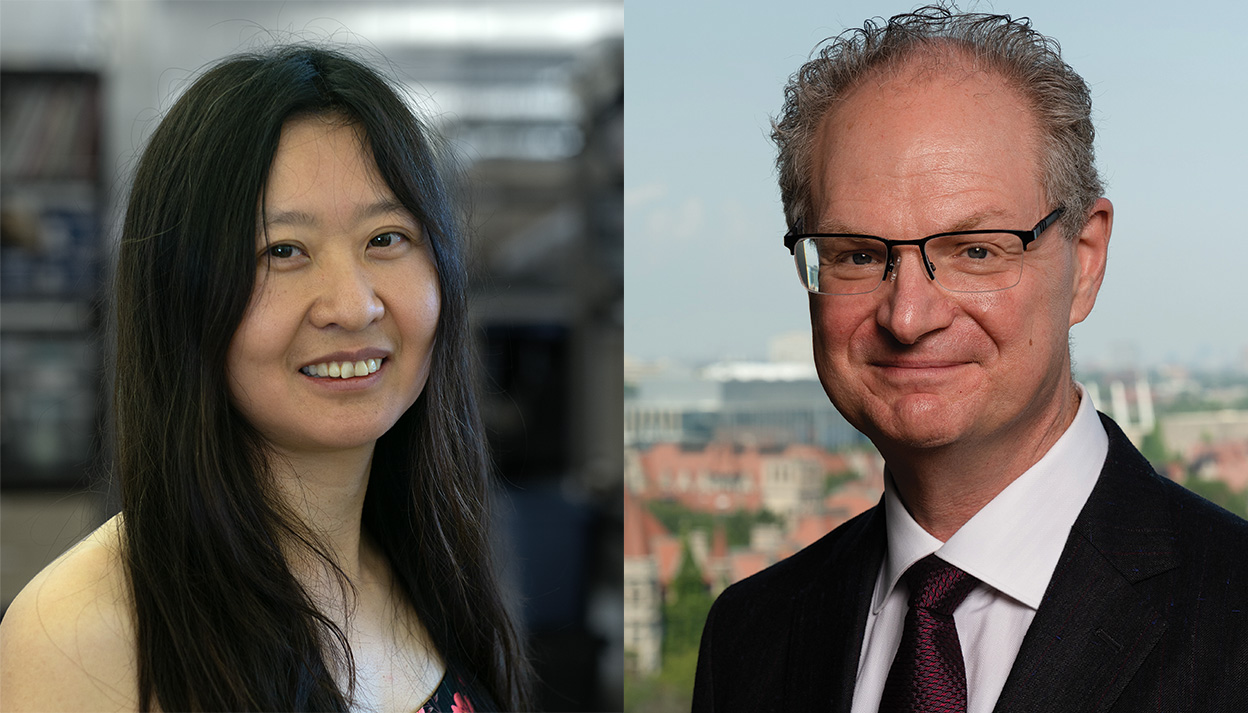UC Berkeley neuroscientist and nanoscientist among this year’s Kavli Prize winners
Doris Tsao shares prize in neuroscience, while Paul Alivisatos shares prize in nanoscience

June 12, 2024
In an announcement today (Wednesday, June 12), the Norwegian Academy of Science and Letters named two University of California, Berkeley, faculty members — Doris Ying Tsao, professor of molecular and cell biology, and Armand Paul Alivisatos, professor emeritus of chemistry — winners of 2024 Kavli Prizes in the fields of neuroscience and nanoscience, respectively.
The prestigious awards, given out since 2008 in the areas of astrophysics, nanoscience and neuroscience, are a partnership among The Norwegian Academy of Science and Letters, The Norwegian Ministry of Education and Research and The Kavli Foundation in the United States.
The awards were announced in a livestreamed presentation from the Johns Hopkins University Bloomberg Center in Washington, D.C. The laureates in each field will share $1 million.
Tsao, who joined the UC Berkeley faculty in 2021, shared the neuroscience prize with two other scientists — Nancy Kanwisher of the Massachusetts Institute of Technology (MIT) in Boston and Winrich Freiwald of Rockefeller University in New York City — for the discovery and study of specific areas in the brain that recognize faces.
Alivisatos, former UC Berkeley vice chancellor and provost, emeritus director of Lawrence Berkeley National Laboratory and currently president of the University of Chicago, shared the nanoscience prize with two scientists — Robert Langer of MIT and Chad Mirkin of Northwestern University in Evanston, Illinois — for engineering nanoscale materials that have improved therapeutics, vaccines, bioimaging and medical diagnostics.
Face recognition
Tsao, a Howard Hughes Medical Institute investigator and member of the Helen Wills Neuroscience Institute at UC Berkeley, is known for brain-mapping studies in the macaque, a primate, that expanded on Kanwisher’s discovery of regions of the human brain involved in recognizing faces. Tsao first used fMRI-guided electrophysiology to pinpoint specific areas in the macaque’s inferotemporal cortex that were activated more strongly when the animals were shown pictures of both human and monkey faces.
She eventually located six “face patches” in the inferotemporal cortex. Then, in collaboration with Freiwald, she inserted electrodes in these areas to study in detail how the neurons responded to different aspects of faces, including the perspective from which the face is viewed.
Through research as a group leader at the University of Bremen in Germany, as a professor at Caltech, her alma mater, and now at UC Berkeley, she has helped reveal the detailed inner workings of face patches. She and her colleagues were able to find a simple code that allowed them to reconstruct in detail a face shown to a monkey simply from the electrical activity in a few hundred neurons. They’ve also discovered the unique code the brain uses to encode familiar faces, providing new insight into how the cortex encodes memories.
In an autobiographical sketch, she described how, as a graduate student in 1997, she felt “bewilderment” at the ability of the brain to “so seamlessly integrate the representation of faces within the face patch system into a larger representation of the environment.”
At UC Berkeley, she is now addressing this broader question, studying how the brain represents the entire 3D space around us. In her words, “How is electrical activity in a thin sheet of cells able to create the percept of objects in space?”
Quantum dots
Alivisatos was a member of the UC Berkeley faculty for 33 years before being named president of his alma mater, the University of Chicago, in 2021. During those years, he made groundbreaking contributions to the fundamental physical chemistry of semiconductor nanocrystals, which are crystals millionths of a millimeter in size that, because of quantum interactions, have properties much different from those of larger crystals.
Today, semiconductor nanocrysals, dubbed quantum dots, are used widely in research, for biological imaging and in consumer electronics. Some quantum dots, for example, change color with size. Alivisatos co-founded a startup called Nanosys Inc., which uses these colored quantum dots to produce bright and energy-efficient computer displays.
The synthesis of nanocrystals that were biocompatible eventually allowed their use in research and diagnostic tools, such as live cell tracking, labelling and in vivo imaging. Alivisatos helped found Quantum Dot Corp., which, in less than two years, brought these biomarkers with a broad range of functionalization to the commercial marketplace, making them readily available to biomedical researchers from around the world.
He also co-invented a technology for making flexible solar cells from rod-shaped semiconductor nanocrystals.
In an autobiography, he credited the “knowledge” environment of UC Berkeley’s College of Chemistry and Berkeley Lab for his success.
“The Berkeley way is to constantly study a subject with a view toward finding where our knowledge is genuinely lacking, to find the way in which our understanding must be upended, to see things in an entirely new light,” he wrote.